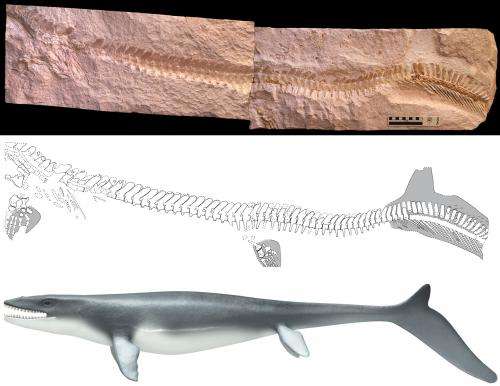September 11, 2013 report
Mosasaur fossil proves the early lizards had tails like sharks

(Phys.org) —A trio of researchers studying a mosasaur fossil found in Jordan report in their paper published in the journal Nature Communications, that the late cretaceous period reptile clearly had a hypocercal (shark-like) tail fin. The fossil was first discovered in 2008 by workers digging at a quarry—it then sat unstudied in Eternal River Museum of Natural History in Amman for four years before this new team of researchers from Sweden, Jordan and the U.S. discovered its existence and began giving it a closer look.
Mosasaurs lived approximately 98 to 66 million years ago during a time when ocean levels were much higher. In their early history, they had legs and feet and likely resembled modern monitor lizards—after moving into shallow lakes, streams and eventually the ocean, they adapted by becoming more streamlined and developed fins and tails. Despite scientists unearthing hundreds of mosasaur fossils, until now, it wasn't known what sort of tail they had developed—none of the specimens found had preserved tail parts. Because they are a part of the lizard family, scientists assumed their tails tapered to a point, which would mean they would have had to swim more like eels, than fish. This new find proves otherwise. Instead of a tapered appendage, mosasaurs developed what looks like upside down shark tail—a development that would have enabled the predators to swim very fast, allowing them to catch most anything in their vicinity.
The fossil found was that of a juvenile, approximately six feet long—adults are believed to have grown to an average of 33 feet. Though small it marks the first instance of a mosasaur fossil with fins, including the tail, almost completely intact. The find settles the debate about which kind of tail the air-breathing swimming lizard had and has caused paleontologist to revisit theories regarding what life in the oceans during the late cretaceous period must have looked like. If masasaurs, which scientists already believed dominated the seas during their time, were able to swim much faster than has been previously thought, it means that other swimmers in the sea likely had to develop adaptations to elude them.

More information: Soft tissue preservation in a fossil marine lizard with a bilobed tail fin, Nature Communications 4, Article number: 2423 DOI: 10.1038/ncomms3423
Abstract
Mosasaurs are secondarily aquatic squamates that became the dominant marine reptiles in the Late Cretaceous about 98–66 million years ago. Although early members of the group possessed body shapes similar to extant monitor lizards, derived forms have traditionally been portrayed as long, sleek animals with broadened, yet ultimately tapering tails. Here we report an extraordinary mosasaur fossil from the Maastrichtian of Harrana in central Jordan, which preserves soft tissues, including high fidelity outlines of a caudal fluke and flippers. This specimen provides the first indisputable evidence that derived mosasaurs were propelled by hypocercal tail fins, a hypothesis that was previously based on comparative skeletal anatomy alone. Ecomorphological comparisons suggest that derived mosasaurs were similar to pelagic sharks in terms of swimming performance, a finding that significantly expands our understanding of the level of aquatic adaptation achieved by these seagoing lizards.
Journal information: Nature Communications
© 2013 Phys.org



















